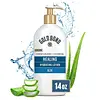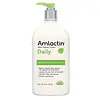What's inside
What's inside
 Key Ingredients
Key Ingredients

 Benefits
Benefits

 Concerns
Concerns

 Ingredients Side-by-side
Ingredients Side-by-side

Water
Skin ConditioningGlycerin
HumectantPetrolatum
EmollientJojoba Esters
EmollientCetyl Alcohol
EmollientAloe Barbadensis Leaf Juice
Skin ConditioningStearyl Alcohol
EmollientDistearyldimonium Chloride
Cetearyl Alcohol
EmollientSteareth-2
EmulsifyingSteareth-21
CleansingPropylene Glycol
HumectantChamomilla Recutita Flower Extract
MaskingPolysorbate 60
EmulsifyingStearamidopropyl Pg-Dimonium Chloride Phosphate
Methyl Gluceth-20
HumectantTocopheryl Acetate
AntioxidantMagnesium Ascorbyl Phosphate
AntioxidantHydrolyzed Collagen
EmollientHydrolyzed Elastin
EmollientRetinyl Palmitate
Skin ConditioningHydrolyzed Jojoba Esters
Skin ConditioningGlyceryl Stearate
EmollientEDTA
Parfum
MaskingPotassium Hydroxide
BufferingDiazolidinyl Urea
PreservativeMethylparaben
PreservativeWater, Glycerin, Petrolatum, Jojoba Esters, Cetyl Alcohol, Aloe Barbadensis Leaf Juice, Stearyl Alcohol, Distearyldimonium Chloride, Cetearyl Alcohol, Steareth-2, Steareth-21, Propylene Glycol, Chamomilla Recutita Flower Extract, Polysorbate 60, Stearamidopropyl Pg-Dimonium Chloride Phosphate, Methyl Gluceth-20, Tocopheryl Acetate, Magnesium Ascorbyl Phosphate, Hydrolyzed Collagen, Hydrolyzed Elastin, Retinyl Palmitate, Hydrolyzed Jojoba Esters, Glyceryl Stearate, EDTA, Parfum, Potassium Hydroxide, Diazolidinyl Urea, Methylparaben
 Reviews
Reviews

Ingredients Explained
These ingredients are found in both products.
Ingredients higher up in an ingredient list are typically present in a larger amount.
Glycerin is already naturally found in your skin. It helps moisturize and protect your skin.
A study from 2016 found glycerin to be more effective as a humectant than AHAs and hyaluronic acid.
As a humectant, it helps the skin stay hydrated by pulling moisture to your skin. The low molecular weight of glycerin allows it to pull moisture into the deeper layers of your skin.
Hydrated skin improves your skin barrier; Your skin barrier helps protect against irritants and bacteria.
Glycerin has also been found to have antimicrobial and antiviral properties. Due to these properties, glycerin is often used in wound and burn treatments.
In cosmetics, glycerin is usually derived from plants such as soybean or palm. However, it can also be sourced from animals, such as tallow or animal fat.
This ingredient is organic, colorless, odorless, and non-toxic.
Glycerin is the name for this ingredient in American English. British English uses Glycerol/Glycerine.
Learn more about GlycerinSteareth-2 is a waxy compound used to emulsify ingredients. It is created from polyethylene glycol and stearyl alcohol.
The 2 stands for the number of ethylene oxide units used to create this ingredient.
We don't have a description for Steareth-21 yet.
Stearyl Alcohol is a type of fatty alcohol from stearic acid. It is a white, waxy compound used to emulsify ingredients.
Fatty Alcohols are most often used as an emollient or to thicken a product. Emollients help soothe and hydrate the skin by trapping moisture.
They are usually derived from natural fats and oils and therefore do not have the same drying or irritating effect as solvent alcohols. FDA allows products labeled "alcohol-free" to have fatty alcohols.
Learn more about Stearyl AlcoholWater. It's the most common cosmetic ingredient of all. You'll usually see it at the top of ingredient lists, meaning that it makes up the largest part of the product.
So why is it so popular? Water most often acts as a solvent - this means that it helps dissolve other ingredients into the formulation.
You'll also recognize water as that liquid we all need to stay alive. If you see this, drink a glass of water. Stay hydrated!
Learn more about Water